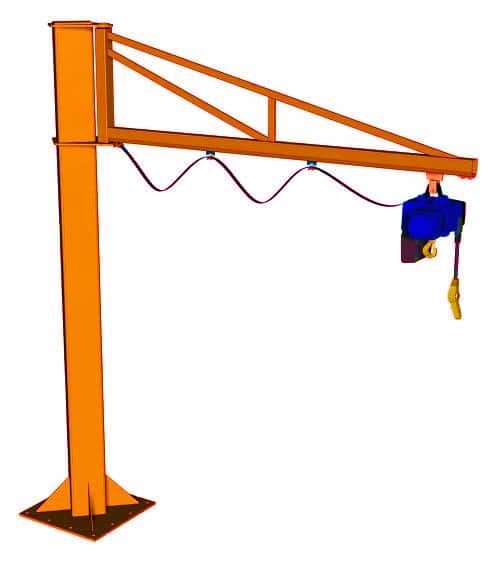ENQUIRE NOW

JIB CRANES
Do you feel like your employees are barely making their targets in terms of production, or that you’re still looking for the last piece to really optimise your manufacturing process? If this is the case, a jib crane may be useful.
A jib crane is a miniature work cell overhead lifting equipment that’s frequently employed in repetitive and unique lifting operations. Jib cranes are extremely adaptable, and they may also be used with overhead bridge cranes to increase production. Jib cranes are simple in design and may have capacities ranging from 250 to 15 tons in some cases. The ergonomic design is appealing in a manufacturing setting since it can boost worker production, minimise workplace injuries, and increase safety.
Our jib cranes are perfect for a variety of applications, including construction, mining, and industrial sites. They are tough and durable and can handle heavy loads with ease. With a Global Track Australia jib crane, you can be sure that you’re getting the best possible performance and value for money.
What are Jib Cranes
Jib cranes are essential in manufacturing settings because they enhance safety, boost production, and reduce injuries among employees. They’re usually simple to use and need little upkeep due to their basic architecture.
To ensure that you build a jib crane system that is both cost-effective and productive for your application, keep the following information in mind:
Duty Cycle/Classification: Choose the right duty cycle or service category to guarantee that the components are sturdy enough to endure the strain and usage demands.
Area of rotation: Towable jib cranes have 360-degree rotation; wall-mounted cranes offer a maximum of 180 degrees.
Height Under Boom: The height under the boom of a jib crane is the distance from the floor to the underside of its boom. Take into account hoist size and how high you’ll need to lift.
Overall jib crane height: Consider any attachments, such as electrical access, to ensure the crane is free of overhead obstructions.
Actual working span needed: The working (or hook) distance is the length of the boom minus half the trolley length on each side.
Power requirements: Will your jib crane’s motor drive, trolley, hoist, or all three need electricity? Will the power come from an electric source or through the air? What type of entrance does it have: bottom or top? Indoor or outdoor usage?
What do Jib Cranes Do
Jib cranes are used to decrease and simplify repetitive lifting operations while also reducing the amount of manual labour. Jib cranes are available in a variety of styles to suit the needs of any sort of lifting or load-bearing application. Jib cranes are one of the most flexible, high-capacity, and low-cost tools available.
Jib Cranes in Manufacturing: Jib cranes are used in many areas of manufacturing. They’re set up at workplaces to assist employees with assembly tasks and are kept near production lines for material handling and transportation.
Cranes for Shipping: Cranes have long been a component of shipping for loading and unloading ships and trucks. In many situations, the cranes are massive and robust, capable of lifting several tons of material.
Construction Industry: Moving huge things into tough-to-reach areas is a constant struggle in the construction business. There are a variety of tasks that you may be engaged in, such as laying pipes, installing and servicing machinery and equipment, and construction site operating activities like erecting tents or lighting fires.
Warehousing and Supply Storage: Gantry and overhead cranes, which can move the whole length of a structure and lift heavy loads, are popular in warehouses and supply storage areas. In such operations, heavy-duty and durable cranes are required to increase material handling efficiency and speed.

